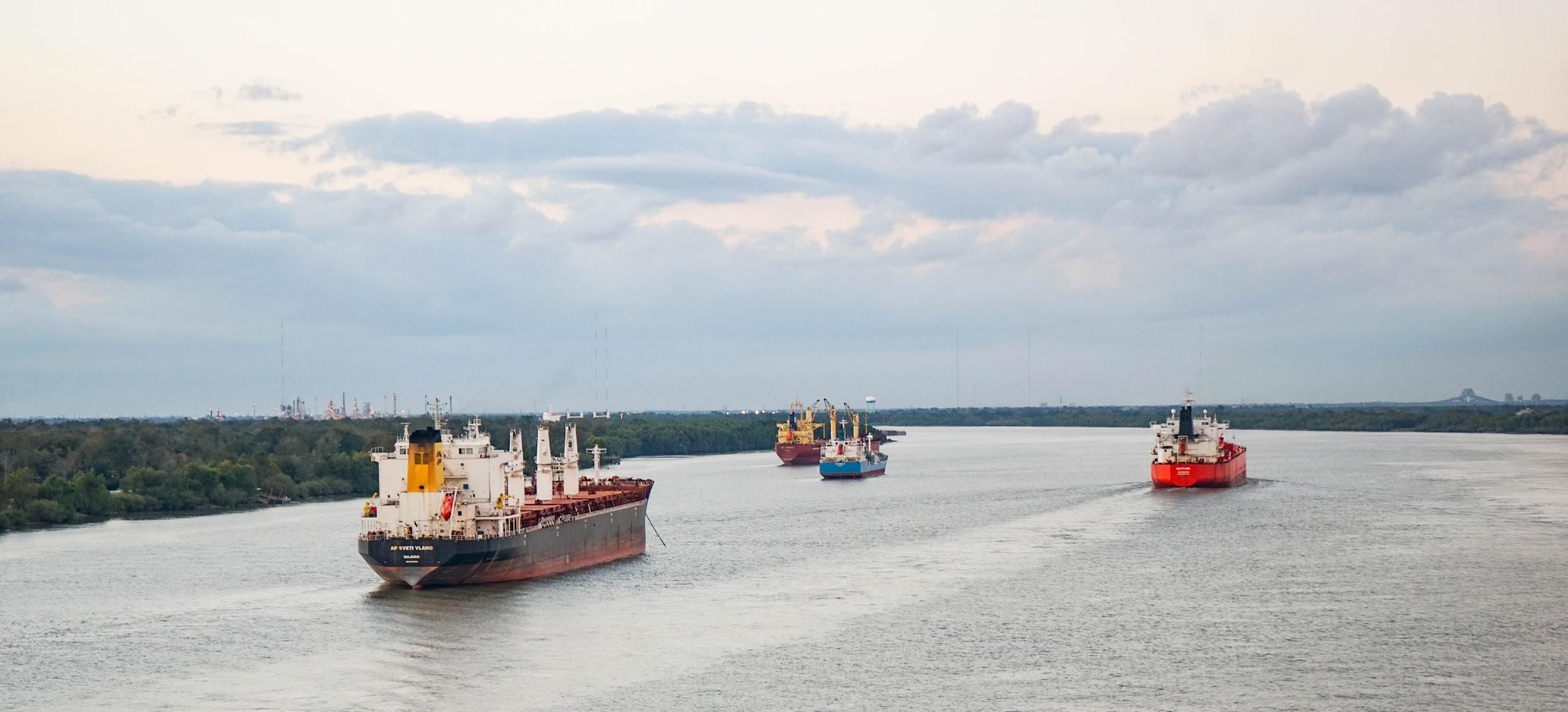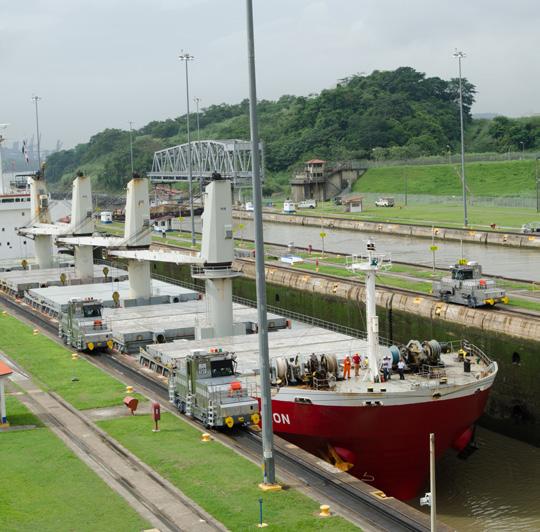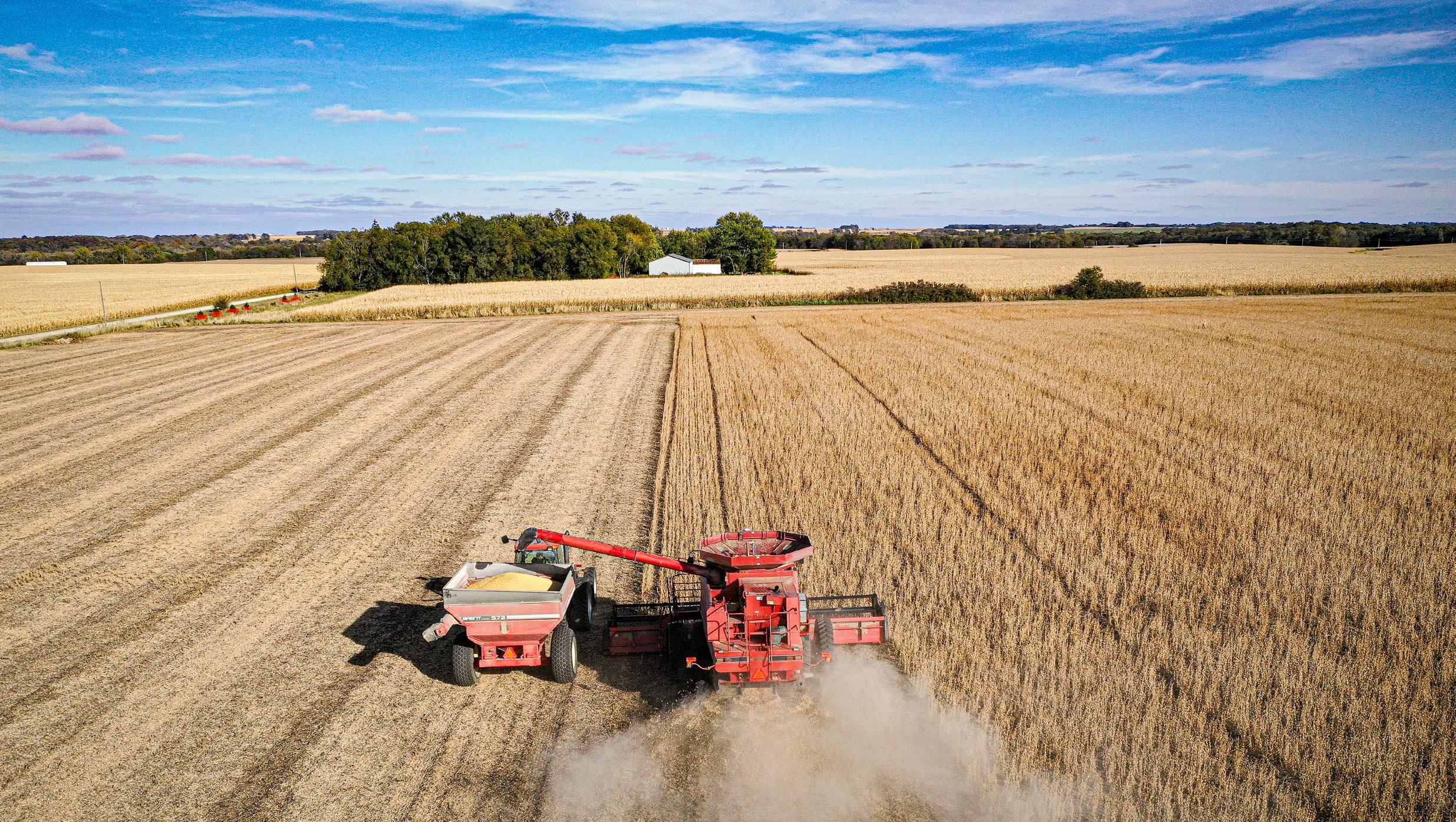
10 minute read
Mighty Mississippi
Project to enhance soybean’s leading export region officially kicks off
BY MIKE STEENHOEK, EXECUTIVE DIRECTOR, SOY TRANSPORTATION COALITION
On July 31, the U.S. Army Corps of Engineers and the State of Louisiana hosted a signing ceremony in New Orleans to officially kick off an important infrastructure project for Iowa soybean farmers and the broader economy – deepening the lower Mississippi River. Governor John Bel Edwards (D-LA) and Major General Diana Holland (U.S. Army Corps of Engineers – Mississippi Valley Division Commander) presided over the ceremony.
The 256-mile stretch of the Mississippi River from Baton Rouge, Louisiana, to the Gulf of Mexico accounts for 60% of U.S. soybean exports and 59% of corn exports – by far the leading export region for both commodities. Soybean farmers and a large number of Mississippi River stakeholders have been promoting the deepening of the lower river shipping channel.
In 2018, the Soy Transportation Coalition (STC) published research highlighting the economic benefits to soybean farmers of deepening the lower Mississippi River from 45 feet to 50 feet. In 2019, the United Soybean Board (USB) announced a $2 million allocation to offset the planning, design and research costs of the project. The American Soybean Association, STC, Iowa Soybean Association and other
— Mike Steenhoek
state soybean associations actively promoted the project to the Trump Administration and congressional and state leaders. This collaborative effort from national and state soybean farmer organizations proved invaluable in helping the project receive necessary funding and approval.
“The soybean industry made for a great case study and reason to deepen the Mississippi River,” says Edwards. “Once this project is complete, the deepening of the Mississippi River will improve the global imports and exports of goods, and in turn, improve jobs, businesses and the quality of life for thousands of Louisianans and others who depend on the Mississippi River. I am grateful for our partnership and the commitment of time and money from

the farming leaders of the USB, STC and countless others who have made this project possible.”
The overall project is estimated to cost $245 million and will occur in three phases. The actual work on the first phase of the project – deepening the river from Venice, Louisiana, to the Gulf of Mexico – is expected to be complete by fall 2021. STC research concludes that shipping costs for soybeans from Mississippi Gulf export terminals would decline 13 cents per bushel ($5 per metric ton) once the lower Mississippi River is dredged to 50 feet A deeper river will allow both larger ships to be utilized and current ships being used to be loaded with more revenue-producing freight. Average vessel loads will increase from 2.4 million bushels of soybeans (66,000 metric tons) to 2.9 million bushels (78,000 metric tons) – a 21% increase or 500,000 bushels.
Research also identifies the impact on interior basis – the difference between the local price a farmer receives and the market value established by the Chicago Board of Trade – for soybeans in 31 states if the lower Mississippi River shipping channel is dredged. It is well established that farmers located in closer proximity to the nation’s inland waterways and barge transportation enjoy a positive or less negative basis verses soybeans grown in areas further removed. As a rule, the less costly and more efficient the supply chain is subsequent to farmers delivering their soybeans, the higher value a farmer will receive for the bushels of soybeans produced.
Contact Mike Steenhoek at msteenhoek@iasoybeans.com.

Spotlight on Soy
Event highlights reliability of U.S. soy

BY BETHANY BARATTA
Spotlight on Soy
Rich, fertile fields and a large geography in which to grow, transport and export soybeans makes the U.S. an ideal supplier of soy to the rest of the world.
Two oceans allow U.S. exports to reach foreign markets. Six, Class 1 railroads and fleets of trucks allow for efficient transportation of soybeans from fields and cooperatives to markets.
“I’m really proud when we load these barges,” says Iowa Soybean Association (ISA) board member Robb Ewoldt, in remarks to 1,000 customers from 69 countries during the virtual U.S. Soy Global Trade Exchange and Specialty Grains Conference.
Living four miles from the river, the terminal to the Mississippi River is a key link between Ewoldt’s farm and customers around the world. Investments in infrastructure are critical to maintaining relationships with customers around the globe. A $2 million checkoff investment into the research, planning, analysis and design helped launch a key infrastructure project. The Mississippi River Deepening Project will dredge the lower Mississippi River from 45 feet to 50 feet. A deeper river will allow both larger ships and current vessels to be loaded with more revenue-producing freight, according to the Soy Transportation Coalition. It will also support soybean prices for U.S. farmers due to intermodal competition.
This is an important investment as 60% of U.S. soybean exports are shipped from ports along the lower Mississippi River. Completion of the dredging project, slated for 2024, means a 10- to 12-cent basis improvement for Ewoldt, who farms near Davenport.
“Ninety percent of our production goes out on a barge,” Ewoldt says. “We realize this is a world market now, and we want to grow the best crop we can because we know that in 20 minutes from this field we could be at a barge terminal loading it.”
Opportunity Springs From Chaos
Uffe Ostegaard, president for shipping company Hapag-Lloyd’s North American operations, says the COVID-19 pandemic has created disruptions in the supply chain. But from chaos comes opportunity to improve.
“We’re working toward quality in the supply chain,” Ostegaard says. “We have a very good integrated supply chain in terms of capacity, frequency, reliability and cost compared to a lot of other markets, and we see the U.S. as being a very good place to work from.” The company is working to improve the speed and overall quality of its shipments. A new online tool connects customers to more proactive information on container shipments. Peter Friedmann, executive director of the Agriculture Transportation Coalition, predicts ocean freight rates to remain stable. He notes that investments in infrastructure are vital to soy export success.
“We must deliver our superior products to foreign markets affordably and dependably,” Friedmann says. “Otherwise foreign buyers will find another source somewhere else in the world.”
Gene Seroka, executive director of the Port of Los Angeles, is a proponent for enhanced communications, which will better line up trucking, rail and container shipments for faster, more efficient delivery.

(Continued on page 30)
Count on U.S.
No matter the delivery method, customers can count on U.S. soybean farmers for all of their soy needs, says Ted McKinney, U.S. Under Secretary of Agriculture for Trade and Foreign Agricultural Affairs. He highlights four main areas in which U.S. soybeans are superior: •

Composition: “The types of soybeans we produce here are second to none around the world, and we’re always chasing that better bean,” McKinney says. Exceptional composition, whether for livestock, aquatics or food processing, is evident in U.S.grown soy.
Consistent supply: Customers around the globe need a reliable and consistent supply of soybeans, and you can count on the U.S. to deliver.
Sustainably produced: Technology has reduced our need to walk beans, as McKinney did growing up on the family farm near Tipton, Indiana. “For areas around the world where sustainability has become very important, even paramount, you can count on it, and we can prove it with U.S. soybeans,” McKinney says.
•Innovation beyond the bushel: “We’re not stopping now with the presumption that soybeans are just for livestock and aquatics,” McKinney says. “It goes way, way beyond that.”
Though COVID-19 halted opportunities to travel to international customers, Ewoldt remains committed to raising GMO and non-GMO soybeans for customers around the world.
“I’ve been down to the Gulf and watched ships being loaded for customers around the world,” Ewoldt says. “I think it’s just amazing that the beans I’m growing this season will be in Japan next year being turned into protein for the Japanese people. It’s a feeling that’s hard to explain to someone else but knowing that you’re feeding a country, such as Japan, is really a neat thing.”
He says he can hardly wait to welcome international customers again on his farm.
“If you ever have the opportunity to come to Iowa, our door is always ope, and we welcome the opportunity to meet you and stand in this very field and talk about soybeans.”
Contact Bethany Baratta at bbaratta@iasoybeans.com.

— Robb Ewoldt
The Last Word

Editor’s Notes by Ann Clinton aclinton@iasoybeans.com
The Farm Truck
His truck, his dash, the county on his tag The songs on his radio, the stickers on his glass From four-bys to two-bys, it’s true you can’t judge A book by its cover, but you can judge a country boy by his truck. –Truck by Hardy
Ifirst heard this song on my teenage daughter’s playlist and it made me laugh out loud. The sentiment is just so true … no matter the age of the country boy, his pickup can tell you a lot about him.
My dad has a truck he calls “Old Red.” It’s a Chevrolet. He’s been pretty loyal to the brand over the years. Well, except for that time in 1988 when he didn’t like the new Chevy body style. In protest, he bought a Ford and drove it until the wheels fell off. “He really showed them,” my mother muses.
“Old Red” is iconic to my family’s farm. It’s hard not to think of my dad without picturing him in that truck. From planting to harvest, that truck has done some serious work.
In the 53 years since they’ve been married, there have been many “Old Reds.” I recently asked them about all their farm pickups and it was fun to listen to them reminisce. Each pickup was driven until it was long past its prime, and only then did they reluctantly start memories in another version.
As a mother of girls who are seemingly too old to be my own, I’m humored by their interest in teenage boys who drive rusted-out pickup trucks. It’s a right of passage, and they will, in their own time, be able to pass more educated judgments of character beyond modes of transportation. But at this point, it’s a generalized love affair.
These teenage boys, who were you not THAT many years ago, will grow up to be the next generation of Carhartt-wearing farmers. They will be listening to their country music as they inevitably raise the highest yielding soybeans the fields have ever seen. They will tackle the environmental challenges confronting agriculture, and accept leadership positions that will propel our industry forward. Just like their truck-driving, forefathers before them.
In this issue, you read about the American Soybean Association (ASA) celebrating its 100th anniversary. What’s truly remarkable, however, is that eight Iowa farmers have served as president of the national organization since its conception in 1920. Those farmers served on your behalf, advancing issues and legislation that has fundamentally advanced the agricultural industry. That’s pretty cool.
In the article entitled, “A Century of Soy,” Iowa Soybean Review staff interviewed five ASA past-presidents from our state. From farm bills and trade agreements to tax incentives and global expansion, these leaders reflected on so many lessons from the past. Regretfully, however, I didn’t think to ask them how many miles were on their trucks. Maybe I’ll do a follow-up article.
My boss has been on me to start a Letters to the Editor section in this magazine for a while now. In the past, I’ve savored the notes you’ve sent as little treasures of insight meant especially for me. Truthfully, I don’t think I can hold off on it any longer without making him seriously question my listening skills. So, I’m creating a new page and I need your wisdom.
Send me a note about your truck. Your first truck. Your last truck. Your good truck. Your work truck. Whatever truck. There’s a story behind each one, so I’m throwing you a softball here. If you’ve ever enjoyed my column and you want me to remain in good standing at my place of employment, I’m gonna need to hear about it.
Stay safe, my friends. I look forward to talking to you soon.



